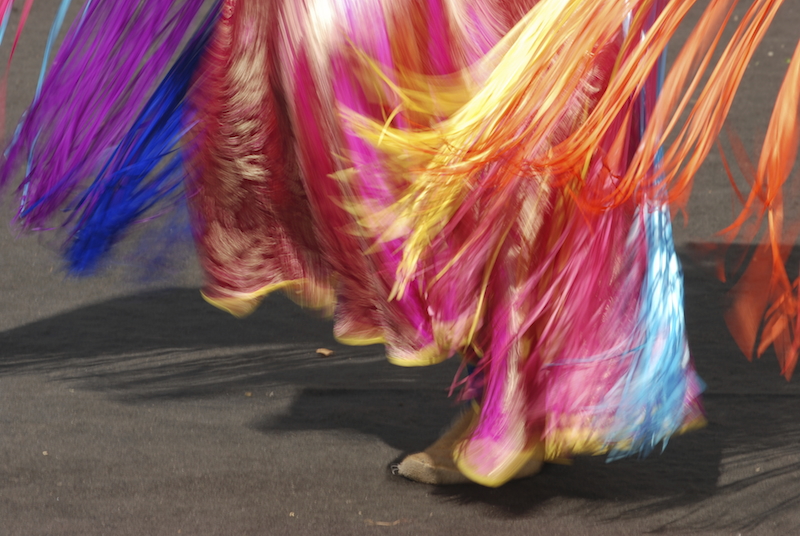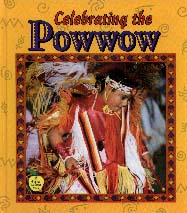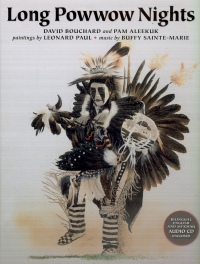
Some books to ready you for the 25th annual Graduation Pow Wow
The 25th annual Traditional Graduation Pow Wow is on May 3. All are welcome to this spectacular event celebrating our Indigenous graduates. To further excite those planning on attending, or entice others, we post three reviews of books celebrating the pow wow. These reviews appeared in CM magazine, which is associated with the University of Manitoba.
Powwow’s Coming
Powwow’s coming, hear the beat?
Powwow’s coming, dancing feet.
Powwow’s coming, hear the drum?
Powwow’s coming… everyone!
That is an excerpt from Linda Boyden’s book, Powwow’s Coming, and although there is no author/illustrator or publisher Canadian connection, the content of the book certainly is relevant to Canada. Boyden is a former schoolteacher who became frustrated by the absence of quality instructional materials useful in teaching about First Nation culture. As such, Boyden decided to create her own materials, and thus was born Powwow’s Coming.
 Told in rhyming text and featuring lavish illustrations, the book is a simple, but attractive, depiction of a First Nation powwow. The sparse text sometimes seems stilted and occasionally loses rhythm, but mostly it maintains the appropriately energetic rhythm of a beating drum. This rhythm mirrors the book content and is reflective of Boyden’s creative talent.
Told in rhyming text and featuring lavish illustrations, the book is a simple, but attractive, depiction of a First Nation powwow. The sparse text sometimes seems stilted and occasionally loses rhythm, but mostly it maintains the appropriately energetic rhythm of a beating drum. This rhythm mirrors the book content and is reflective of Boyden’s creative talent.
The colourful cut paper collages are the strength of the book. Many of the papers used for the illustrations include corrugations and obvious fibres. Other papers are woven together. These elements add depth and texture to the artwork. Much of the paper also has a leathery appearance, suggestive of traditional dress. String and feathers are also included in the collages, adding further texture to the illustrations.
The illustrations are visually appealing. Boyden’s artwork includes strong use of colour, including a heavy reliance on red, yellow, black and white, which in some First Nation cultures are sacred colours reflective of the medicine wheel or the four directions. The circle motif also regularly reappears in the illustrations, further emphasizing the careful attention to detail contained in Boyden’s artwork.
For me, the most striking illustration is that of the feathered dancer in the middle of the arena circle. Another interesting illustration shows a grandmother reading to her grandchildren in preparation for the powwow. The book the woman is reading is none other than Powwow’s Coming — a fun, if shameless, piece of self-promotion that I enjoy.
The final page of the book contains additional information about powwows. Included on this page are several suggestions about powwow etiquette. The final page also includes an explanation of the rules for a couple of First Nation games.
Having had the good fortune to attend many powwows, I enjoyed the book. I was reminded of the multi-sensory treat that is a First Nation powwow. This book certainly suggests powwows are for men and women and for young and old. Throughout the book, people are depicted in a mixture of contemporary and traditional dress, ranging from jeans and t-shirts through to highly decorative dancing costumes. The book is itself a celebration—a celebration of powwow celebrations.
Gregory Bryan teaches children’s literature in the Faculty of Education at the University of Manitoba.
This review appeared in CM magazine, April 18, 2008.
Celebrating the Powwow
A powwow is a colorful event that involves dancing and drumming. It is the oldest North American celebration. Powwows are held throughout the United States and Canada. They can take place indoors, but most are held outdoors. The First Nations people gather to celebrate their individual cultures and shared beliefs.
 Following the format of most Crabtree books, Celebrating the Powwow is rich in illustration with this volume including beautiful photographs bounded by brilliant primaries and interspersed with drawings. Some of the text has an underlay of drawings or designs, and photographs are sometimes set over drawings. In one example, feathers are underlaid where the text describes regalia . This approach makes the book visually exciting and attractive and will draw people into the subject. In some parts of Canada, powwows will be familiar and well-known. In others, this book will provide a wonderful introduction to the spirituality, pageantry and community which characterize powwows.
Following the format of most Crabtree books, Celebrating the Powwow is rich in illustration with this volume including beautiful photographs bounded by brilliant primaries and interspersed with drawings. Some of the text has an underlay of drawings or designs, and photographs are sometimes set over drawings. In one example, feathers are underlaid where the text describes regalia . This approach makes the book visually exciting and attractive and will draw people into the subject. In some parts of Canada, powwows will be familiar and well-known. In others, this book will provide a wonderful introduction to the spirituality, pageantry and community which characterize powwows.
The information is presented with new or significant terms printed in bold. A contents page, (“What is in this book?”), glossary (“Words to know”) and an index take readers through the subject with ease. Kalman covers the topic with thoroughness and provides detailed illustrations of regalia for both women and men. This book fills a gap in the materials available for elementary school students who are studying First Nations. Library shelves are full of books on traditional lifestyles, but few which explore current practices are appropriate to these grade levels. Although the material will answer questions, the format may present a problem for older students who want items of a more mature look.
Reviewer Jennifer Johnson works as a librarian in Ottawa.
This review appeared in CM magazine, January 7, 2000.
Long Powwow Nights
I remember you mother – still vibrant and young
Dancing beneath the warm prairie sun.
I now know those days were an endless desire
That burned deep within you like the flames of our fire.
Red Deer Press’s new picture book, Long Powwow Nights, is a celebration of powwows and their importance to First Nation people. In Long Powwow Nights, a child has been taught by his mother to respect and appreciate the powwow ceremony and First Nation culture. The narrator reflects upon his mother’s love of the dance and his mother’s life and teachings as she grows older and, eventually, dies.
 Long Powwow Nights is a collaboration of many talented and creative people. The poetic text was written by Pam Aleekuk and the prolific and talented Métis writer, David Bouchard. The book includes dual English and Mi’kmaq text. The Mi’kmaq translation is by Patsy Paul-Martin while the stunning illustrations are by Leonard Paul. The book also contains a CD recording of the book read in English and the Mi’kmaq language. This CD includes accompanying music by Buffy Sainte-Marie, recipient of the Lifetime Achievement Honour from the Canadian Aboriginal Music Awards. The collaboration works very well, and, at less than $25, the book and CD represents good value. Red Deer Press has also released a French edition of the book, with French and Mi’kmaq text.
Long Powwow Nights is a collaboration of many talented and creative people. The poetic text was written by Pam Aleekuk and the prolific and talented Métis writer, David Bouchard. The book includes dual English and Mi’kmaq text. The Mi’kmaq translation is by Patsy Paul-Martin while the stunning illustrations are by Leonard Paul. The book also contains a CD recording of the book read in English and the Mi’kmaq language. This CD includes accompanying music by Buffy Sainte-Marie, recipient of the Lifetime Achievement Honour from the Canadian Aboriginal Music Awards. The collaboration works very well, and, at less than $25, the book and CD represents good value. Red Deer Press has also released a French edition of the book, with French and Mi’kmaq text.
Leonard Paul’s wonderful artwork is the major strength of Long Powwow Nights. The magnificent paintings have a photographic realism that, given the subject matter, is beautiful and awe-inspiring. Paul’s paintings of powwow dancers in full regalia are likely to draw the attention of the panel of judges who determine the Governor General’s Literary Award for illustration of books for children. The paintings reflect the dancers’ pride and capture the colour and energy of a powwow.
Bouchard’s and Aleekuk’s text is nostalgic and respectful but demands maturity of the reader, and that means this book is not best suited to young readers. Although the promotional materials suggest the book is suitable for all ages, the text is not likely to appeal to many readers or listeners below grade five or six level. Given the dramatic beauty of the artwork, however, many young children will be content to turn the pages and focus exclusively on the dramatic paintings.
Long Powwow Nights is a stunning book that will especially appeal to First Nation People and to anyone who has enjoyed the opportunity to attend a powwow ceremony.
Gregory Bryan teaches children’s literature in the Faculty of Education at the University of Manitoba.
This review appeared in CM magazine, Janurary 8, 2010.






